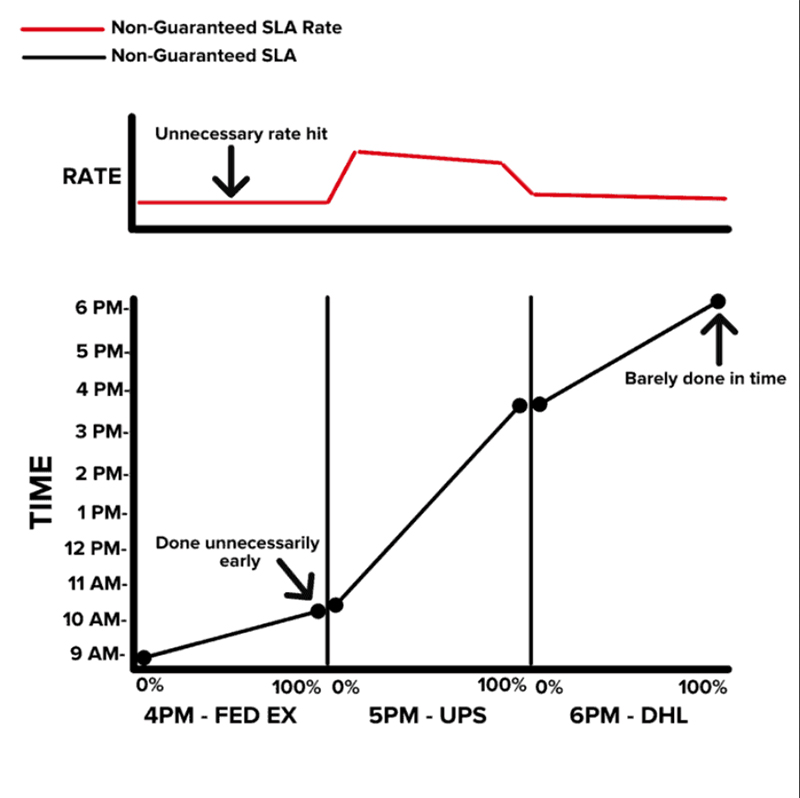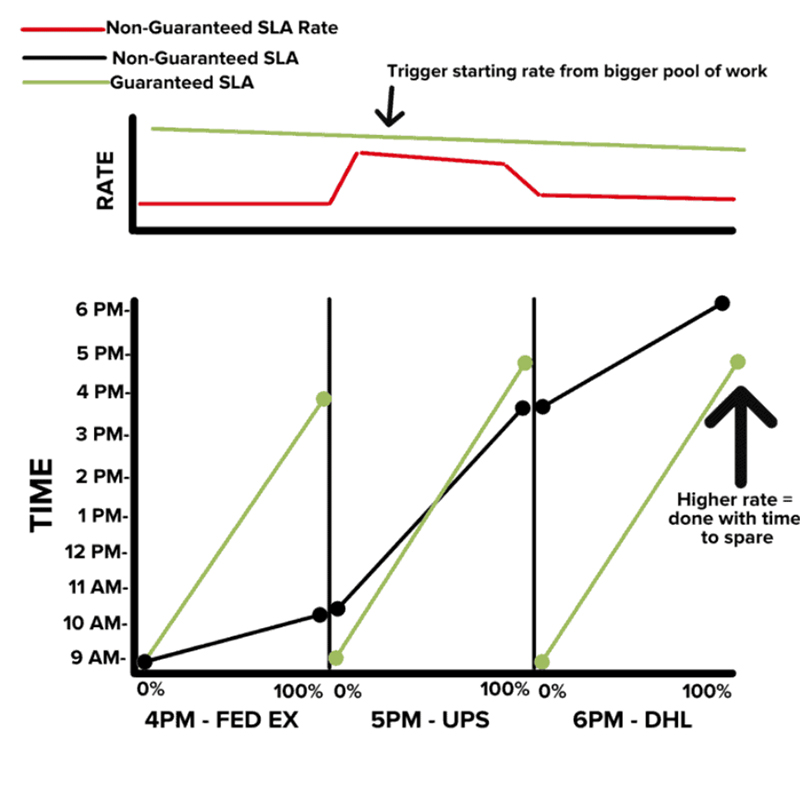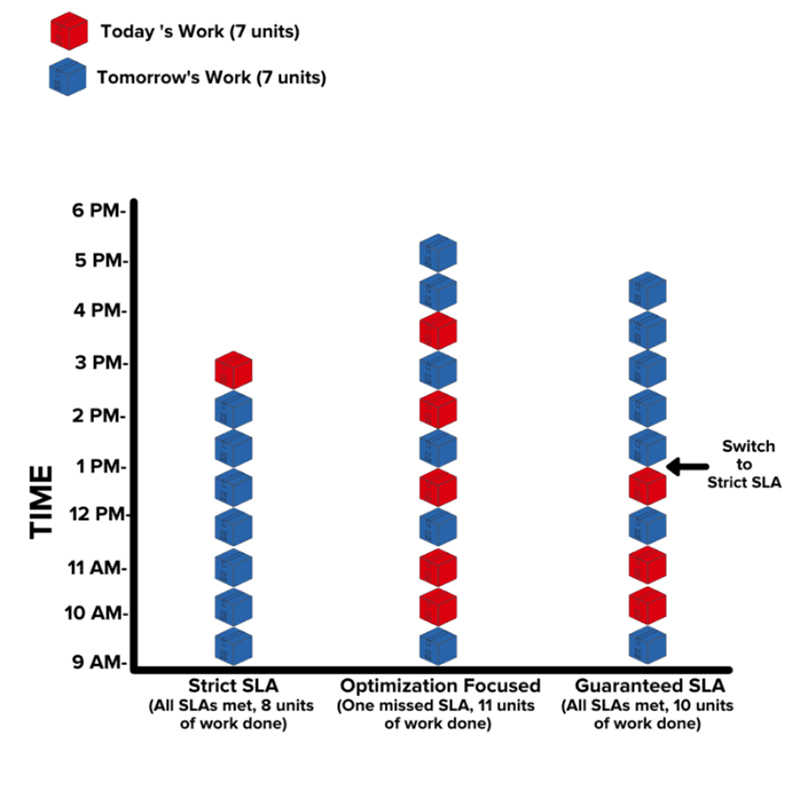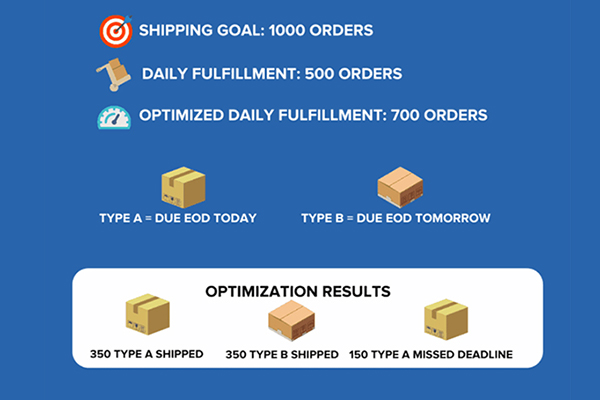Below we’ll take a closer look at why many techniques like prioritization and optimization fall short and how the 6 River Systems Guaranteed SLA (GSLA) solution helps operations meet more critical deadlines.
Prioritization and Optimization
Prioritization and Optimization are two approaches many operations use when deciding how to fulfill orders:
- Prioritization is how much a customer wants an order to ship next and usually based on a combination of the order’s SLA and allocation rules.
- Optimization is taking the order that will ship next and applying the most efficient technique to fulfill it.
When choosing an order for picking tasks, there is traditionally a tradeoff between strict Service Level Agreement (SLA) adherence or prioritization versus optimizing the work as much as possible (Note: this article assumes that SLAs are represented as “pick by” deadlines).
Most optimization techniques work to get products out of the warehouse either as fast as possible or as cost effectively as possible, with some combination of the two being yet another option. These techniques, which are complimentary, seem compatible with meeting SLAs but are not the same and are often at odds.
The Common Solution
Historically, the industry uses techniques that focus on prioritization or optimization. If the focus is on prioritization, it often comes at a large expense of throughput. If the focus is purely on optimization, it often comes at the expense of missing SLAs. Although there are some operations where one of these is acceptable, most need a bit of both. The solution many operations use is to fulfill orders in small waves, with the most demanding SLAs first. These waves are then internally optimized for throughput. Although this has some benefits, it does result in two problems:
- From a management perspective, floor operators constantly monitor the state of work and drop pick waves when they see the previous one finishing up. They also have to manage wave sizes: too big and the SLAs might not be met, too small, and they cannot be optimized well. Determining how big the waves should be and when to release orders is often something learned over time and is “tribal knowledge” which can get lost if a key employee leaves and ultimately is subject to human error.
- Due to enforcement of SLAs, wave sizes often severely limit what the optimization technique can do, which significantly limits the potential performance gains. The result is that, as a warehouse approaches its throughput capacity, especially during peaks, less work goes out the door. While current SLAs may be met, future SLAs are put in jeopardy which is less than ideal. This effectively robs long-term attainment to pay for short-term attainment.
Enter Guaranteed SLA by 6 River Systems
The 6 River Systems solution is an active and dynamic optimization technique that enforces hard SLAs while still making fulfillment operations as efficient as possible. Guaranteed SLA allows operators to drop off many fulfillment orders and associate each order with an SLA. Management burden for floor operators is reduced and 6 River Systems’ optimization algorithms are empowered to work with as many options as possible.
How does Guaranteed SLA work?
6 River Systems’ algorithms take the machine rate plus the body of work and the number of Chucks in the system, to calculate how long the site would take to complete current work. If there is little to no capacity left, the system focuses resources on the work that needs to be done to meet the prioritized SLA. If there is spare capacity, then the system optimizes across all of the work, with only a slight preference towards jobs with closer SLAs. As work is fulfilled and new work is added the system actively updates these calculations to make sure that we are running as dynamic an operation as possible, while still hitting deadlines.

Above the graph shows a scenario where the site uses traditional picking for its three pull times: FedEx at 4pm, UPS at 5pm, DHL at 6pm. This operation may wave each pull time separately, pick through to completion, then wave the next in. As shown in the graph, they picked FedEx to completion by 10:30am — an unnecessary early finish, then wave UPS and pick until 3:30pm and finally wave DHL but barely finish by the 6pm pull time. If you look at this operation’s rate information, they took a strong rate hit because the FedEx pool of work was small.

The graph above shows the difference when picking with 6 River Systems’ Guaranteed SLA feature. With Guaranteed SLA the system was able to identify with the current pick rate so none of the pull times were in danger of running late. The FedEx, UPS and DHL orders were picked together which optimized labor utilization. Guaranteed SLA helped the operation hit a higher pick rate and finish all pull times with more time to spare. If one of the pull times was in danger, the system would shift its focus on that pull time until it was back on track.

In the graph above, each column represents a different way of selecting which orders to fulfill. With Guaranteed SLA, the focus is on shipping all of today’s orders on time while performing better than the Strict SLA option. The Optimization Focused option is the most ideal selection but it will result in missing some SLAs.
What if SLAs still can’t be met?
Many times, during peaks, operations will surpass their maximum capacity and SLAs can’t be met. Unfortunately, no amount of prioritization can help when the system has more work than it can handle. GSLA will perform better or equal to strict SLA in this case.
Once GSLA determines that we are getting close to missing our deadlines it will act exactly like a strict SLA system will. On the other hand, when there is some additional capacity it will result in a higher rate, reducing the chance to end up in a situation where SLAs can’t be met. That being said, when SLAs can’t be met, the best actions to take are:
- For operators to use GSLA’s options to prioritize orders based on the following circumstances:
- Closest to missing their deadline
- Running late and in danger of missing their deadlines
- To prevent any missed deadlines in the future
To add more associates or get more Chucks to help with the workload.
Summary
There is often a competition between meeting SLAs and running the most efficient operation. As SLA requirements get tighter, the competition intensifies. 6 River Systems’ GSLA function allows dynamic adjustments to provide as much optimization as possible, while honoring shipping dates. In some operations, the cost of missing SLAs is low and emphasis should be placed on being efficient; other operations are extremely sensitive to missing SLAs.
In the former case, it is possible to turn off the GSLA feature to focus primarily on efficiency. For the majority of operations where missed SLAs are very costly, GSLA is a powerful feature which allows you to introduce flexibility into your operation and reduce complications for floor managers without the risk of compromising important shipping dates.
Article topics
Email Sign Up




















